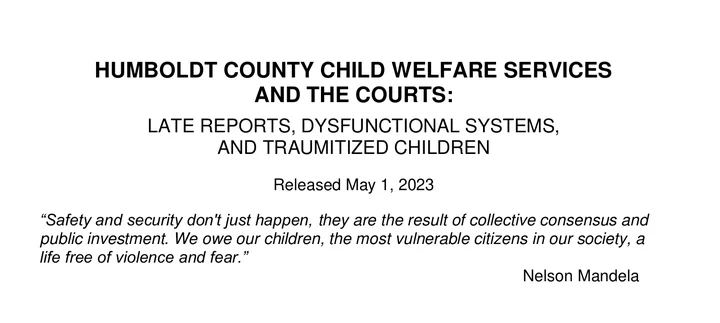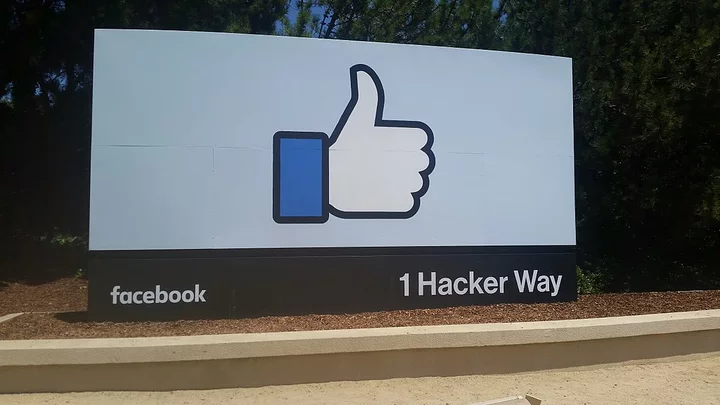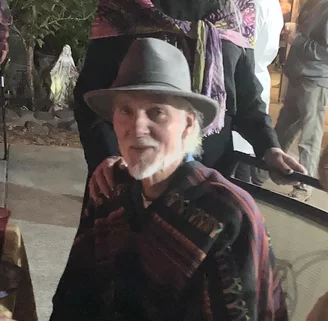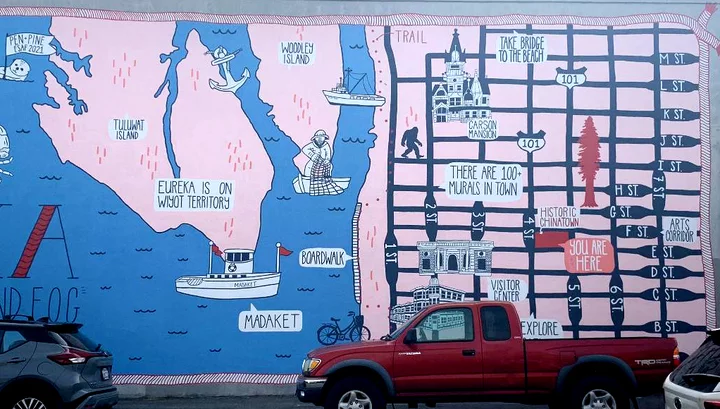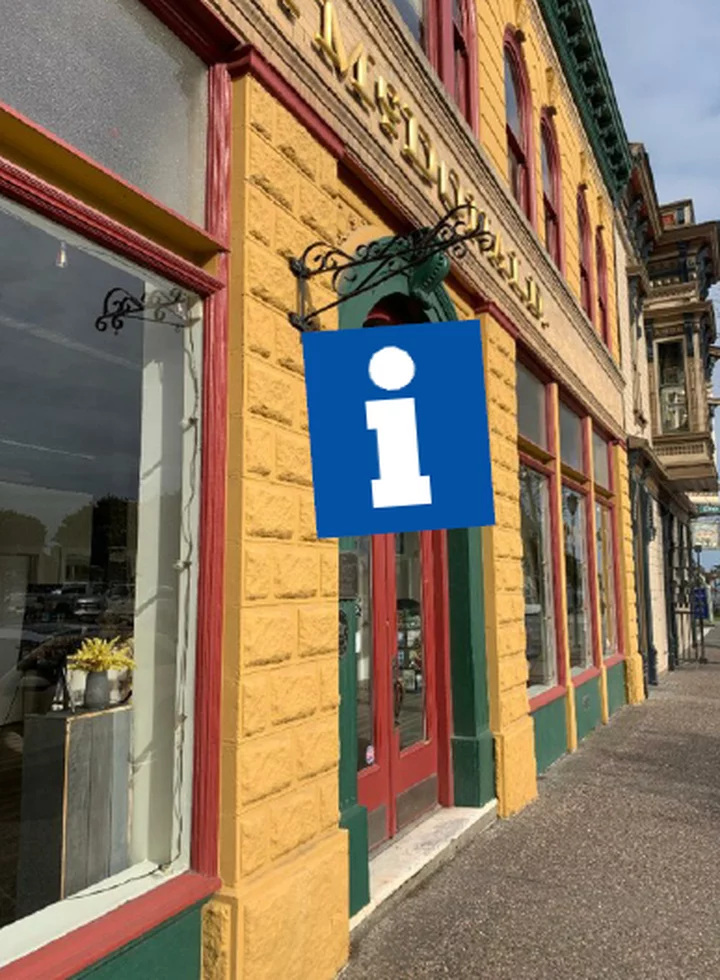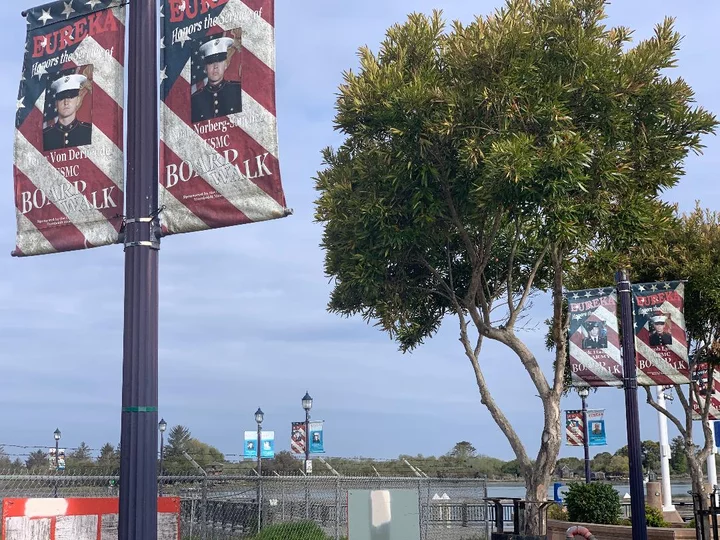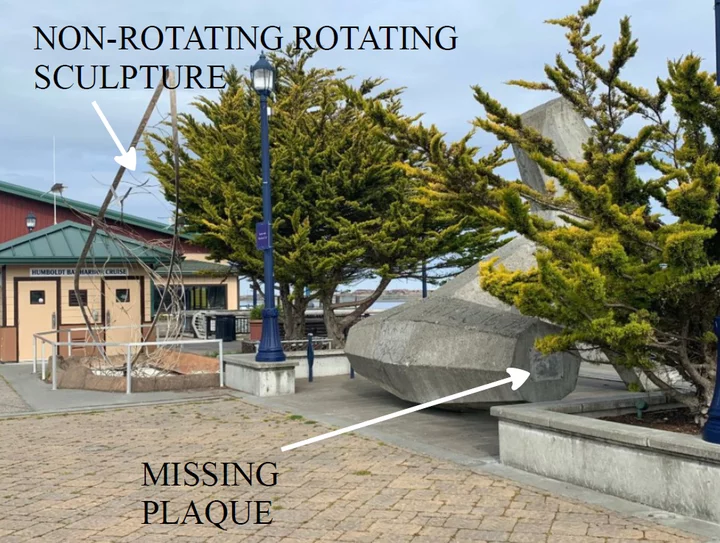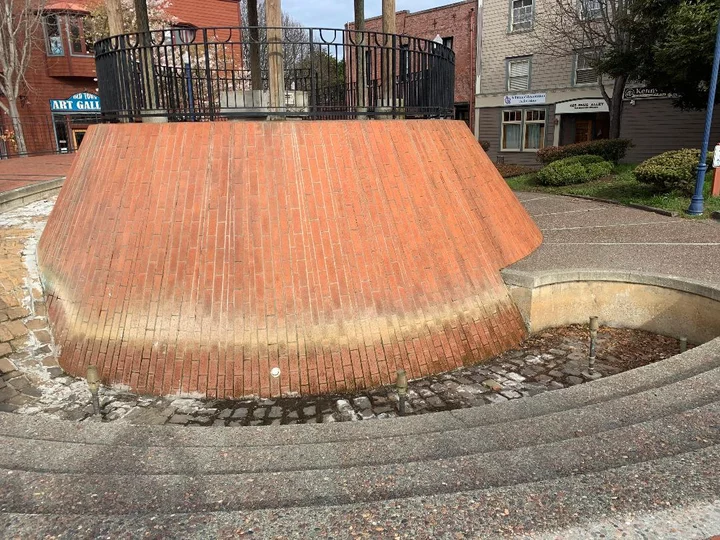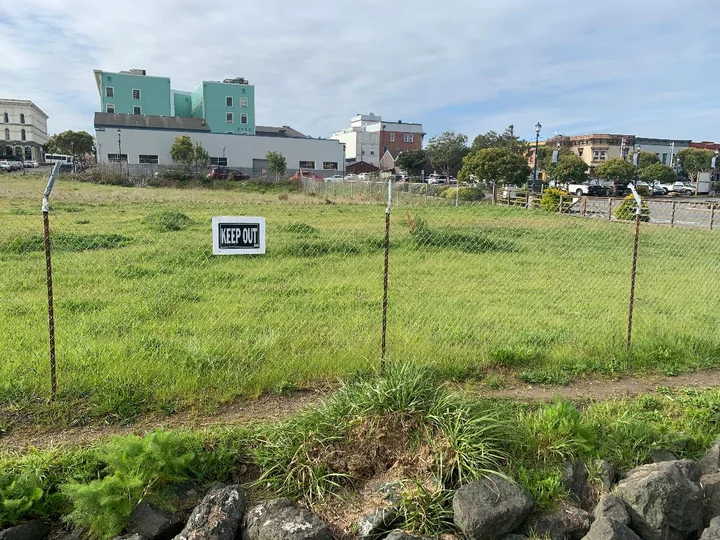HUMBOLDT TODAY with John Kennedy O’Connor | May 1, 2023
LoCO Staff / Monday, May 1, 2023 @ 4:20 p.m. / Humboldt Today
HUMBOLDT TODAY: A local woman has been crowned Miss Indian World 2023!; the Humboldt County Board of Supervisors will consider an anti-hate resolution; plus, your latest weather and our daily poll in today’s online newscast with John Kennedy O’Connor.
FURTHER READING:
- In its Second Report of the Year, the Humboldt County Civil Grand Jury Tackles the ‘Dysfunctional’ State of Child Welfare Services in the County and the ‘Toxic’ Work Atmosphere Within the Department
- Humboldt Supervisors to Brainstorm Ways to Maintain Roads, Consider an Anti-Hate Resolution in Response to ‘Vicious and Hateful’ Message Aimed at Black, LGBTQ+ Communities
- YÉESHIIP! Local Woman Brings Home Miss Indian World Title
- California’s Next Housing Crackdown Could Force Cities to Plan More Homeless Shelters
- Lawmakers Want More Social Media Regulation. Here Are the Legal Hurdles They Could Face
BOOKED
Today: 11 felonies, 16 misdemeanors, 0 infractions
JUDGED
Humboldt County Superior Court Calendar: Today
CHP REPORTS
444 Mm299 W Tri 4.40 (RD office): Trfc Collision-1141 Enrt
ELSEWHERE
Governor’s Office: Governor Newsom announces appointments 12.12.2025
County of Humboldt Meetings: Fish & Game Advisory Commission Agenda - Regular Meeting
Governor’s Office: TIME’s Person of the Year was Made in California
Governor’s Office: Governor Newsom visits LA recovery efforts in Altadena and the Palisades, views homes set to be completed soon
In its Second Report of the Year, the Humboldt County Civil Grand Jury Tackles the ‘Dysfunctional’ State of Child Welfare Services in the County and the ‘Toxic’ Work Atmosphere Within the Department
Hank Sims / Monday, May 1, 2023 @ 2:32 p.m. / Local Government
Image from the title page of the report
###
PREVIOUSLY:
###
Today, the Humboldt County Civil Grand Jury released the second of its reports for the 2022-2023 year — and if anyone expected it to continue on in the celebratory vein of the first one, on the county’s election systems .. well, they are in for a disappointment.
This second report takes aim at what the GJ calls the “dysfunctional” state of child welfare services in Humboldt County — and not just the county department nominally in charge of those things, but the county’s entire system for handling children who are victims of abuse or neglect.
In short, while the Grand Jury found that the people who work for the county’s Child Welfare Services division care deeply about the health and welfare of the children they work to protect, there are serious problems with morale, stress, overwork and burnout among employees — much of it, according to the Grand Jury, caused by understaffing.
Not only has this led to what several people characterized as a “toxic” work environment within the department; additionally, it has led directly to the missing of state-mandated paperwork deadlines dealing with cases of abuse or neglect.
What to do? The GJ’s main recommendations all revolve around beefing up and streamlining the recruitment process for new employees. Currently, the jury says, the Child Welfare Services department only has a recruitment relationship with the Social Work department at Cal Poly Humboldt. There are many more pools to draw from.
Download the complete Grand Jury report here. Press release from the Humboldt County Grand Jury:
The 2022-23 Humboldt County Civil Grand Jury) Grand Jury has just released its first report of the year entitled Humboldt County Child Welfare Services and the Courts: Late Reports, Dysfunctional Systems, and Traumatized Children.
The 2022-23 Humboldt County Civil Grand Jury received a complaint that Child Welfare Services routinely misses statutory deadlines for submitting reports to the Humboldt County Superior Court.
These delays create unnecessary stress for children and families.
Over the last decade the Humboldt County Civil Grand Jury has investigated numerous complaints about the Department of Health and Human Services. While the nature of those complaints have differed, the introduction to the 2015-2016 Humboldt County Civil Grand Jury report stating—“those complaints conveyed dysfunctional work guidelines, distrustful working relationships, unresponsive upper management, mass resignations, and an unsupportive work environment” —largely reflects the essence of our current report. This 2022-23 report argues for significant changes in Child Welfare Services.
Child Welfare Services is charged with one of the most valued functions of our county government. Their job is to intervene when abuse or neglect is suspected or evident and make the best decisions for that child’s well-being. Not having enough social workers has resulted in case overload and missed mandated court reports. Institutional roadblocks regarding staffing, overtime, and child and family attorney interactions with County Counsel have all slowed the court process and possible family reunification.
Everyone we interviewed connected with CWS for this investigation has demonstrated a genuine passion for improving the lives of children here in Humboldt County. However, they all confirmed that the lack of staffing, recruitment and retention, lengthy hiring and vetting processes, high caseloads, long hours, high staff turnover, absenteeism, moral injury, and bureaucratic red tape is causing job burnout.
This report examines the causes and effects of the court report delays and the understaffed departments at CWS. It looks at ways CWS can employ non-traditional ways to improve staff recruitment, hiring, and retention, which ultimately will lead to the timely permanent placement of our children, Humboldt County’s most precious resource.
The intent of the 2022-23 Humboldt County Civil Grand Jury is to support an understaffed and overworked Child Welfare Services agency and the child dependency legal system by informing the citizens of Humboldt County of its findings and making long-term positive impacts with its recommendations.
YÉESHIIP! Local Woman Brings Home Miss Indian World Title
Hank Sims / Monday, May 1, 2023 @ 10:11 a.m. / Our Culture
Today Humboldt County is insanely proud of Eureka resident Tori McConnell, who was named Miss Indian World 2023 at this weekend’s Gathering of Nations powwow in Albuquerque, New Mexico.
McConnell, who is of Karuk and Yurok descent, tells us in the video above that she’s a graduate of the Native American Studies program at UC Davis, and was just accepted into the graduate program in Community and Environment at Cal Poly Humboldt, where she’s planning a course of study on traditional tattooing techniques.
Congratulations, Tori!
California’s Next Housing Crackdown Could Force Cities to Plan More Homeless Shelters
Marisa Kendall / Monday, May 1, 2023 @ 7:11 a.m. / Sacramento
Muhammad, who declined to provide his last name, warms his hands at a fire next to his tent in Sacramento. Feb. 24, 2022. Photo by Miguel Gutierrez Jr., CalMatters
All over California, cities are falling far short when it comes to providing enough shelter for their homeless communities.
More than 69,000 homeless residents live in Los Angeles County, for instance, but that county has just over 21,000 beds in shelters and temporary housing programs.
It’s a similar story in Sacramento County, which counted nearly 9,300 unhoused residents in its last census, but has just over 3,000 shelter and temporary housing beds.
Those massive gaps – which ensure thousands of people remain homeless – are visible in cities throughout California. But despite constant reassurances from Gov. Gavin Newsom and lawmakers that getting people off the street is a top priority, there’s no state requirement for cities and counties to make sure they have enough shelters or housing for homeless residents.
A bill working its way through the Legislature could change that, and potentially lead to sanctions against local governments that fail to plan for the needs of homeless Californians.
Senate Bill 7 would — for the first time — require cities and counties to plan enough beds for everyone living without a place to call home. It would go beyond just temporary shelter, also including permanent housing placements.
Its author, Sen. Catherine Blakespear, a Democrat from Encinitas, called it a “transformational idea” that could help move the needle on homelessness where other attempts have failed.
“Everything we’re doing currently, it will result in homelessness growing,” Blakespear said in an interview. “It will not result in homelessness going down.”
California cities’ housing goals
Currently, the state makes sure every city and county plans for new housing through a process known as the regional housing needs allocation. In all, the state requires cities and counties to plan for 2.5 million new homes over the next eight years — about 25% of which must be affordable for very low-income occupants.
But this method doesn’t require cities and counties to plan any housing that is specifically for homeless residents.
If the bill passes, local officials would have to include homeless housing in their plans. How much is yet to be determined, but it would be based on each city’s point-in-time census count of its homeless population. Ideally, Blakespear said, the plans would require a unit for every single person counted.
The idea comes at a time when the state is forcing local governments to take more responsibility for providing housing.
Newsom’s administration sued the Orange County coastal enclave of Huntington Beach earlier this year for failing to adopt a housing plan. And cities that flout state housing law also are subject to the “builder’s remedy,” which allows developers to bypass local zoning laws for certain projects.
Blakespear’s bill has gained some early support from housing activists, and recently passed out of the Senate Governance and Finance Committee by a 6-2 vote. While some local leaders are sure to chafe under yet another state-imposed housing requirement, several big-city mayors are tentatively supportive.
“The final details in the bill matter,” Sacramento Mayor Darrell Steinberg said in an emailed statement, “but any bill that moves the state and cities closer to making housing and services for the homeless a mandatory obligation for government is a step in the right direction.”
Data collected by Sacramento County’s homeless services agencies shows the county has 3,080 beds in its year-round shelters and transitional housing programs — 6,198 fewer than its estimated total number of unhoused residents.
Los Angeles County has 21,100 placements in its temporary housing, safe parking and motel programs, according to a county dashboard — not enough to accommodate even a third of its unhoused population.
Advocates want more money for homeless housing
At a recent hearing, some bill critics wondered where the money would come from to build all this extra housing.
“The funding’s going to be incredibly critical,” said Jason Rhine, assistant director of legislative affairs for the League of California Cities. “If we do not have the money, we will not be able to house individuals.”
The league hasn’t officially opposed the bill, but says it has concerns.
Blakespear wants to pair her bill with a new state fund, which would help cities, counties and nonprofits build housing for people who are homeless or at risk of losing their homes. But it remains to be seen how much — if any — money the Legislature allocates, as the state faces a budget deficit of at least $22.5 billion this year.
Some aspects of the legislation are still up for negotiation. It’s unclear what type of homeless housing cities and counties could use to fulfill the new requirements. Blakespear envisions it would include both permanent and temporary — meaning apartments, but also shelters, RV sites, single-room-occupancy hotels, and more.
It’s also unclear exactly what each city and county would be on the hook for under the new bill, and what the penalties would be for noncompliance. The state’s current process requires cities to plan for housing, including zoning for it and removing roadblocks from its construction, but doesn’t require them to get it built.
Much of the housing cities plan for during that state-mandated process never gets constructed. And low-income housing fares the worst. In the last eight-year planning cycle, just 20% of the very-low-income units needed statewide were permitted.
The California Building Industry Association opposes Blakespear’s bill, worrying money to fund it would come from raising taxes and fees paid by homebuilders. Furthermore, existing law already requires cities and counties to assess their need for emergency shelter, said Cornelious Burke, the association’s vice president of legislative affairs.
Blakespear said she has no intention of using construction fees to cover the cost of her bill. And she disagreed the state’s existing shelter-assessment requirement renders her bill unnecessary.
“Those are just words,” she said. “That is not an actual obligation to provide anything for people who are unhoused.”
Ray Bramson of Destination: Home, a nonprofit that helps spearhead the homelessness response in Santa Clara County, said the bill could help get more homeless housing built. But it depends on how the details of the bill shake out, he said. For one thing, the bill should focus on permanent housing that comes with supportive services like mental health care – not on temporary shelter, Bramson said.
And, the bill must come with funding.
“If not,” he said, “then it’s just another goal that we’re going to struggle to meet collectively.”
###
CalMatters.org is a nonprofit, nonpartisan media venture explaining California policies and politics.
Lawmakers Want More Social Media Regulation. Here Are the Legal Hurdles They Could Face
Grace Gedye / Monday, May 1, 2023 @ 7:06 a.m. / Sacramento
Minette Lontsie, CC BY-SA 4.0, via Wikimedia Commons
###
When Sophie Szew first downloaded Instagram at her 10th birthday party, she was exposed to a flurry of information that “promoted eating disorders,” she told California lawmakers. By 15, she said, she was following “every starvation regimen recommended” by Instagram’s “explore” page.
Szew, now 20, spoke in Sacramento at a Senate hearing in April in support of an expansive bill making its way through the Legislature. It would hold companies legally responsible for using algorithms and design features that addict young people.
“Standing with me today is a generation that knows all too well what it is like to be harmed by flawed systems,” she said.
The past few years have seen a steady drip of research and reporting about the effects of social media on teens. That has translated into a stream of legislative activity across the country, with several states passing or considering laws that regulate how social media companies do business.
In 2022, when researchers for a nonprofit created TikTok profiles posing as 13-year old girls in the U.S., U.K., Australia and Canada, they scrolled through videos served to them, stopping to watch and like videos about eating disorders, body image, and mental health. They found that TikTok recommended suicide content within 2.6 minutes and eating disorder content within 8 minutes.
In 2021, after a whistleblower leaked documents, the Wall Street Journal reported that researchers at Meta, formerly known as Facebook, found that 32% of teen girls said that when they felt bad about their bodies, Instagram made them feel worse. Meta owns Instagram..
CalMatters reached out to Twitter, Reddit, Mastodon, TikTok and Meta, which also owns WhatsApp, for comment. Twitter’s press inbox responded automatically with a poop emoji. Reddit, Mastodon, and TikTok did not respond.
In a statement, Meta’s Global Head of Safety, Antigone Davis, wrote that Meta wants teens to be safe online: “We don’t allow content that promotes suicide, self-harm or eating disorders, and of the content we remove or take action on, we identify over 99% of it before it’s reported to us.”
Rachel Holland, a Meta spokesperson, offered information on a variety of features teens and parents can use to shape what young people see, like a setting that makes new teen users less likely to encounter sensitive content, and a feature that nudges teens when they’ve been scrolling through the same kind of content for a while.
What the California bill does
The bill takes aim at how social media companies serve up content to young people under 18. Specifically, it prohibits social media companies from using a design, algorithm, feature, or practice, that companies know (or should know) causes young people to:
- Develop an eating disorder, inflict harm on themselves or others, or become addicted to the social media platform;
- Receive content that facilitates the purchase of controlled substances, like opioids; that facilitates suicide by offering information on how to die by suicide; or facilitates the sale of guns illegally.
It covers social media companies that earn more than $100 million in revenue per year and have users in California. Companies that violate the law could get sued by public attorneys, and would face penalties of as much as $250,000 per violation.
But the bill also builds in a way for companies to protect themselves from lawsuits: By auditing their designs, algorithms, features, and more at least quarterly for their potential to cause the harms listed in the bill and correcting issues within 30 days.
“If you look at a bill like this, the crux of the problem is content.”
— Sophie Cope, Senior Staff Attorney, Electronic Frontier Foundation
California isn’t the only state where legislators are aiming to regulate social media platforms. In March, Utah’s governor signed a similar bill into law, plus another law that institutes a social media curfew for Utah teens under 18 and requires teens to get their parents’ permission to set up social media accounts. Arkansas also passed a law requiring parental permission for teens to set up social media accounts. State legislators in New Jersey are considering a bill that prohibits social media companies from using features that addict kids, and lawmakers in Minnesota are also mulling a social media bill. Then, there are the bills that would regulate social media with a different aim: Texas passed a law that made it illegal to ban users based on their “viewpoints,” and Florida also passed a law restricting platforms’ ability to ban users.
On top of all the new proposals, there are a bevy of lawsuits ping-ponging their way through the courts that could reshape social media regulation. The Texas and Florida laws were challenged for violating the First Amendment; the Supreme Court will decide their fate. More than 80 cases have been grouped together in one jumbo lawsuit, in which plaintiffs say that the social media platforms are essentially defective products — like an exploding toaster — because they addict children.
California bill could face legal hurdles
If the California bill became law, would it be able to dodge and weave its way through legal challenges?
Tech industry lobbyists, as well as some digital rights advocates and internet law experts, say that the bill would immediately bump up against the First Amendment of the U.S. Constitution and federal law. Both outrank or “pre-empt” in lawyer-speak, California laws.
The bill runs afoul of the Constitution because the Supreme Court has generally interpreted the First Amendment as protecting the editorial decisions of publishers, said Sophie Cope, a senior staff attorney at the nonprofit Electronic Frontier Foundation, which opposes the bill. Newspapers decide their layout, what goes on the front page and which images to use, Cope said. Social media platforms are doing similar things as online publishers when they make decisions about how content is displayed, shared, or promoted, she said.
This bill “goes directly at the heart of the editorial discretion of these platforms,” Cope said.
“It’s the First Amendment that restricts the ability of legislators to control the flow of information at children” to the degree legislators might want, agreed Eric Goldman, a professor at Santa Clara University School of Law and an expert on internet law. His example: a Supreme Court case from 1997 about whether a law prohibiting the transmission of porn or “obscene or indecent” messages to kids violated the first amendment. The Supreme Court decided unanimously that it did.
Ed Howard, senior counsel for the Children’s Advocacy Institute at the University of San Diego School of Law and a supporter of the bill, disagrees, and argues that the bill doesn’t violate the First Amendment, in part because the algorithms that prioritize what content gets displayed don’t have their own First Amendment rights. And, he said, “there is no blanket immunity to harm people through your speech.”
Then, there’s a federal law that could pose a problem for the California bill. Section 230 of the Communications Decency Act generally protects tech companies from legal responsibility for content posted by users on their platforms. If, for example, someone posts a defamatory review of a restaurant on Yelp, the restaurant owner could sue the poster, but Yelp itself would be protected, said Cope.
So, a key question is whether the California bill is taking aim at features and algorithms that a social media company has designed — for which it may not be protected by Section 230 — or if it’s really requiring platforms to be accountable for content that users upload.
State Sen. Nancy Skinner, an Oakland Democrat who authored the bill, argues that the bill holds companies liable for their own products and practices, so it wouldn’t be preempted by Section 230. Part of the government’s job, she said, “is to protect consumers from harmful business practices. That’s a very classic role of government.”
But, said Cope with the Electronic Frontier Foundation, “if you look at a bill like this, the crux of the problem is content.” The bill is structured to make platforms “responsible for bad content reaching young people,” so the federal law should pre-empt it, she said. The features, in other words, aren’t a problem when they’re showing #vanlife and knitting videos to young users, but when they’re serving up starvation diet tips, they are.
Public may be left in suspense
Last week the bill was sent to the Senate Appropriations Committee and added to a special pile of bills that the committee will analyze for costs and benefits. That pile of bills — known as the “suspense file” — is officially about budget analysis. Unofficially, it’s also a politically expedient place for lawmakers to kill bills without taking any heat. That’s because, unlike other votes that state legislators take, votes on suspense file bills are kept secret. If a bill never makes it out of the special pile, the public doesn’t know whose votes led to its demise.
A version of the bill was introduced last year. No legislator voted against it publicly, but the bill was put on suspense file and died there.
This year’s bill “could suffer that fate,” said Skinner, “but I’m hopeful that the amount of increased awareness, increased evidence and action by other states will hopefully put it in much better shape,” she said.
###
CalMatters.org is a nonprofit, nonpartisan media venture explaining California policies and politics.
OBITUARY: Steven Blahnik, 1952-2023
LoCO Staff / Monday, May 1, 2023 @ 6:56 a.m. / Obits
Steven
Blahnik
February
10, 1952 - March 28, 2023
Steven passed away on March 28 at 4:20 p.m. after a short-lived but intense illness.
He was born in Algoma, Wisconsin and graduated from high school in Oregon, Wisconsin. He started the University of Wisconsin, Oshkosh, playing basketball as in high school until one day in 1972 he was walking across campus and saw it was -70 degrees wind chill factor, and “decided right then and there to move to San Francisco.
In San Francisco Steven worked various jobs, using his bicycle for transportation up and down the hilly city until he went back to Wisconsin to take a long bicycle trip with a friend from Wisconsin to California. Their bikes gave out around Montana so they decided to hop a freight and, luckily, met a railroad yard man who told them exactly what to do to get to San Francisco; how to do it and don’t dilly dally around, just follow instructions by a rail guy they would meet in Seattle. An early 1970s Wisconsin hippy riding the rails!
After arriving back in San Francisco he met his first wife, Simone and had his first child, Eli. They separated after three years and he raised Eli on his own most of the time, working again at various jobs — a handyman, teacher at a preschool and volunteered at an open classroom, until he began carpentry and construction, which would be his life career. At the beginning of his career he met Andre, his new business partner and lifelong friend, who joined him in a multitude of jobs from building a house out of a railroad car to rehabbing the Majestic Hotel on Sutter Street in San Francisco. Steven lived in cooperative housing until a landslide ran right through the building in 1983. A few years after, Steven married Eleanor and had his second child, his daughter Gabriele. They moved to Humboldt, built a yurt and he worked with his new partner, Dan, on many construction projects throughout Southern Humboldt.
After divorcing Eleanor he met his soul mate of 24 years, Kathy Wolff, in 1999 at a grocery store, and together they proceeded to purchase land in Larabee Valley, build a house from scratch, move in sheep, a horse, sometimes pigs and chickens, and live sustainably off the land for the past 21 years. He continued to work construction projects until 2008, when he retired to be a full time farmer. In 2010 he volunteered to take the EMT class to work as a volunteer for STAR (Southern Trinity Area Rescue) and spent many long hours working with STAR as an EMT for 9 years.
Steven loved the Full Moon Drum Circles, had a Wisconsin wit, carved beautiful wood pieces, did special project construction for friends and neighbors, coordinated an all-volunteer crew to replace a much needed residents roof and was an ethical, valuable member of our community. His personal interests ranged from spirituality to metaphysics to baking sourdough bread. Talking of politics and war, he would quote “Everyone should go home and make bread.”
He left behind his loving longtime partner, Kathy Wolff, his sisters Constance and Lisa, his son Eli, his daughter Gabriele, his step sons Ritchie and Charlie, his stepdaughter Crissy, his grandchildren Sabrina, David, Iriana, Ryan and Aidan, his great-grandchildren Kendra and Kendall, his niece Tanya and his nephew Alex.
A celebration of Steven’s Life will be held at Grizzly Creek Campground, Saturday, June 25 at 4 p.m.
###
The obituary above was submitted on behalf of Steven Blahnik‘s loved ones. The Lost Coast Outpost runs obituaries of Humboldt County residents at no charge. See guidelines here. Email news@lostcoastoutpost.com.
GROWING OLD UNGRACEFULLY: Good, Bad and Ugly Eureka — Small Investments, Big Payoffs
Barry Evans / Sunday, April 30, 2023 @ 7 a.m. / Growing Old Ungracefully
Eureka needs tourist dollars, especially since the lumber and fishing industries which once financed public works are now barely viable. Trying to see the Old Town from a tourist’s perspective, here are some of my pet kudos and pet peeves: Eureka’s Good, Bad and Ugly.
The Good
All photos: Barry Evans.
Murals! We’ve got great murals—over 100 of them, according to the mural-map (above) on E at 4th, right at the entrance to our newly designated Chinatown. The map also reminds us that we’re on Wiyot land—Jaroujiji, which extended from Little River to the Bear River ridge south of the Eel. Our murals include: Duane (El Pulpo Mechanico) Flatmo’s huge mural celebrating the Arkley Center for the Performing Arts—at 70 ft. high, it’s probably the tallest mural north of San Francisco; Randy Spicer’s “Satchmo” nearby; Blake Reagan’s paean to Billie Holiday on the side of The Speakeasy; Dan Kitchener’s Tokyo-at-Night scene in Opera Alley at H (painted in just a week, freehand); and many, many more.
The Boardwalk, completed in January 2002—giving locals and tourists alike access to Humboldt Bay, complete with a tour boat, M/V Madaket, scheduled to begin service again in mid-May.
Waterfront trails, north and south. The 1.5 mile Hikshari’ Trail running south from Truesdale is currently being extended south which will eventually, ojalá, be part of a future Great Redwood Trail. Meanwhile, the comparatively new trail from Adorni to Target will soon (next year, if all goes well) be the southernmost portion of the entire Eureka to Arcata trail—can’t wait!
The Bad
Visitor Center. You know where it is, right? No? It recently moved to new digs on the Gazebo, but you’d never know it: no sign, no sandwich board outside, no flags, nothing. Everywhere else where there’s a tourist office—everywhere, I swear (Europe, Canada, Mexico, South America, Asia…) you find it by looking for the white lowercase “i” on a blue background. If our local office did have such a sign, it would be swinging from the convenient bar right outside. (I’ve been asking about this for three years now, only to be told, “It’s in the works.”
This is how it should look!
Militarized Boardwalk. Not really, but do we have to celebrate the fact that our region has several active service men and women? Not all of us supported, or support, the invasions of Iraq and Afghanistan, and I suspect many visitors might feel the same.
Madaket Plaza. Last August, 42-ton dolos* #1972 (celebrating the year it was cast) was moved from the old Chamber of Commerce parking lot to the Madaket Plaza, courtesy of Leroy Zerlang, Kernan Construction and North Coast Fabricators (despite the City Council previously giving the nod to its destruction). The day it was moved, the explanatory plaque “dedicated to the seafaring men [sic] of Humboldt—past present and future” was removed to “polish up.” (Couldn’t it have been polished in situ?) Eight months later it’s still being “restored.” (I’m quoting city staff.) This is part of our heritage, and visitors deserve to know what it’s doing there. (If you’re unsure, check out this link).
* Dolos = singular, dolosse = plural. (Afrikaans)
Meanwhile, right next to the dolos, Jack Sewell’s dynamic aluminum sculpture Following Current Events just sits there in its empty pond, not turning as it was designed to do—and as it did for seven years after installation. It’s evolution from a rotating feature to a static blade is a long and complicated story, but in my mind, this is such a tourist draw that the City should be paying to upgrade the pump (if that’s what it takes) and to maintain it. With the infrastructure already there and paid for, this is an opportunity to be seized, rather than a problem to be solved.
While we’re at the plaza, note the six concrete plinths on both sides as you walk in from First Street at C. These used to support local artists’ metal sculptures, but I’m told they were victims of vandalism. So, rather than surrender to idiots how about being proactive? Security cameras? Security guards? Stronger sculptures? Fences?
The Gazebo. Speaking of empty ponds, when’s the last time you saw the water in the stone chute running down from the Gazebo, with its three fountain jets, actually working? They’ve been having problems with the pump, I know, but c’mon guys! This is a worthy feature, and it’s so tacky, not to mention hazardous, when empty. Oh, and benches? Tourists like taking a break from time to time! We used to have a slew of benches in Old Town, but most are now gone (“Homeless people were using them…”—sigh). Put in lots of benches, for our homeless and tourists alike! That’s what grown-up towns do!
Waterfront park. Where? Other cities have created waterfront parks as long-term investments for locals and visitors, and we could do the same. Consider the lovely field at the east end of the boardwalk behind Bayfront One. Yeah it’s privately owned and yeah, it’ll take a lot of money and work, but a park here would beautify Old Town and pay off in appreciation by tourists. Bite the bullet, people! Buy the land, clean it up, plant trees, install trails, picnic benches, a kids’ playground! We lesser mortals will love you for it.
The Ugly
Trees, lack of. For a future column.

